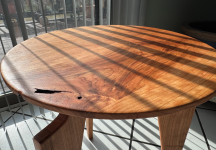First, here's a note on the Nakashima Woodworkers site about caring for your piece:
https://nakashimawoodworkers.com/wp-content/uploads/2018/10/Notes-On-Care-2018.pdf
If your piece is looking dry and worn after several years of heavy use, it may be time to renew your oil finish. If you wish to try this yourself, we recommend using Sutherland Welles Tung Oil Wiping Varnish / High Luster, making sure it is applied in a well-ventilated location.
That said, Sutherland Welles just started in 1965. None of the pieces I have (from the 1960s and 1970s) are finished with a wiping varnish, certainly not a high luster. They have always been matte, maybe eggshell at most, so I suspect they are pure tung oil finished. Sutherland Welles doesn't sell pure tung oil (but it is available from a number of places, including even Amazon), but they do sell Polymerized Tung Oil, which I think is boiled to help it dry and build faster. I think a wiping varnish would have been too glossy for George, but obviously Mira should know best. I do think maybe she's just responding to what clients want (shiner) and finding a product that's easy to apply and dries pretty quickly.
I've used a lot of pure tung oil on a wood called Narra, which is like Padauk in that it's dark and slightly oily itself. With pure tung oil, sand as high as you want (more for higher sheen) then apply it and keep it barely wet for a while - like 30 minutes. Then wipe off any excess and let it dry. That will take a while. Like at least 3 days. I've found that I often can put a second coat on in only a day or two, but it doesn't really build unless the first coat is dry.
Maybe sacrilege, but I've recently started using Odie's Oil with great results. You apply the same way: rub it on, let it sit, keeping it barely wet, for at least 30 minutes (60-90 seems best) then rub all the excess off. Then a few days later apply a second coat if you want. Odie's seems to build faster for me and two coats does the trick for indoor stuff while with pure tung oil I would go for 3 coats. That said, I've done 1 one with pure tung for some things (baby rattles) in the past with good results. Depends on what you want.
I find that Odie's dries faster and harder than pure tung, but the depth and sheen are about the same, maybe even better with Odies. That said, I'm using darkish woods - light woods like maple might be a different story than Cherry and Narra.
As for "what look is done" - that's up to your personal preference. I like to barely have some sheen, but anything that could be called shiny is too much for me. Others may not think it's "done" until it's somewhat shiny. Heck, I used a resin/oil finish on my wood floors, and had to get the matte version since everything else was too shiny. I used that floor finish (Sutherland Welles' "Murdochs") on the wood fronts of my new dishwasher and it turned out great and I think will hold up better than the low-luster tung oil wiping varnish I previously used.
For my upcoming desk, I'm planning on using Odies.
EDIT: [member=75933]luvmytoolz[/member] is right that pure tung oil takes a really long time to completely dry. The 3 days I mentioned above is for recoating, and longer is indeed better if you have the time. I would not try to have thick coats with pure tung oil - you have to wipe off whatever hasn't soaked into the wood if you don't want shiny spots as it dries. Thick coats not only take longer to dry, they don't have any real strength. And even with thin coats you're not going to get a thickish build of any quality. You need a resin in the finish to get some build I think.

